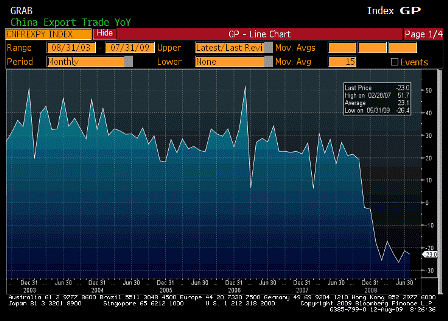Yes, this further supports the notion that some of the world economic improvement was due indirectly to ‘one time’ inventory building and additions to capacity in China, including the eurozone, where exports nudged France and Germany to positive GDP reports.
Hong Kong Climbs Out of Recession as Trade Improves
August 14 (Bloomberg) — Hong Kong climbed out of a yearlong recession as trade improved, adding to signs that the global economy is recovering.
Gross domestic product rose a seasonally adjusted 3.3 percent in the second quarter from the previous three months, after dropping 4.3 percent in the first quarter, the government
said today. The median estimate in a Bloomberg News survey of seven economists was for a 1.2 percent gain.
The Hang Seng Index has gained 84 percent from this year’s low in March as China’s record lending and 4 trillion yuan ($585 billion) stimulus package help the city, which is a hub for
trade and finance. Hong Kong’s government raised its forecast for this year’s GDP to a contraction of between 3.5 percent and 4.5 percent today from a previous estimate of a 5.5 percent to
6.5 percent decline.
“This rebound has largely been ‘Made in China,’†said Brian Jackson, a senior strategist at Royal Bank of Canada in Hong Kong. “Exports to the mainland have picked up, while easy
liquidity conditions there have contributed to recent gains in Hong Kong’s asset prices, providing a strong boost to Hong Kong consumers.â€
The economy shrank 3.8 percent in the second quarter from a year earlier, after a 7.8 percent drop in the previous three months. The first-quarter contraction from the previous three
months was the worst since data began in 1990.
Singapore Retail Sales Post Smaller Drop as Recession Recedes
By Stephanie Phang
August 14 (Bloomberg) — Singapore’s retail sales fell the least in three months in June as the nation emerged from its worst recession since independence 44 years ago and an annual island-wide sale supported spending.
The retail sales index dropped 8.2 percent from a year earlier after sliding a revised 10.4 percent in May, the Statistics Department said today. The median estimate of 11 economists surveyed by Bloomberg News was for a 9.2 percent decline. Adjusted for seasonal factors, sales rose 2.3 percent from May.
Singapore’s economy expanded for the first time in a year last quarter as manufacturing and services improved. The government raised its 2009 export forecast this week as policy makers around the world predict the worst of the global recession is past after pledging about $2 trillion in stimulus measures and cutting interest rates.
“We should generally expect gradual improvement in retail sales from hereon,†said Kit Wei Zheng, an economist at Citigroup Inc. in Singapore. He cited “firmer signs of a turnaround in labor markets, and perhaps some positive spillovers on confidence from the buoyant property and equity markets.â€
Singapore’s benchmark stock index has climbed 49 percent this year and home sales by developers including Frasers Centrepoint Ltd. rose 9.1 percent in June from May, according to the Urban Redevelopment Authority.
Singapore employers fired fewer workers last quarter, cutting 5,500 jobs compared with 12,760 in the first three months of the year, the Ministry of Manpower said July 31. The seasonally adjusted unemployment rate held at 3.3 percent.
[top]



